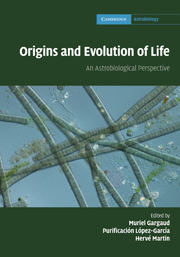Book contents
- Frontmatter
- Contents
- List of contributors
- Foreword
- Preface
- Part I What is life?
- Part II Astronomical and geophysical context of the emergence of life
- Part III The role of water in the emergence of life
- Part IV From non-living systems to life
- Part V Mechanisms for life evolution
- Part VI Life in extreme conditions
- Part VII Traces of life and biosignatures
- 25 Early life: nature, distribution and evolution
- 26 Early eukaryotes in Precambrian oceans
- 27 Biomineralization mechanisms
- 28 Limits of life and the biosphere: lessons from the detection of microorganisms in the deep sea and deep subsurface of the Earth
- Part VIII Life elsewhere?
- Index
28 - Limits of life and the biosphere: lessons from the detection of microorganisms in the deep sea and deep subsurface of the Earth
from Part VII - Traces of life and biosignatures
Published online by Cambridge University Press: 04 February 2011
- Frontmatter
- Contents
- List of contributors
- Foreword
- Preface
- Part I What is life?
- Part II Astronomical and geophysical context of the emergence of life
- Part III The role of water in the emergence of life
- Part IV From non-living systems to life
- Part V Mechanisms for life evolution
- Part VI Life in extreme conditions
- Part VII Traces of life and biosignatures
- 25 Early life: nature, distribution and evolution
- 26 Early eukaryotes in Precambrian oceans
- 27 Biomineralization mechanisms
- 28 Limits of life and the biosphere: lessons from the detection of microorganisms in the deep sea and deep subsurface of the Earth
- Part VIII Life elsewhere?
- Index
Summary
Naturally occurring physical and chemical constraints of life and the biosphere
Deep-sea and deep-subsurface environments have been recognized to be among the most extreme biotopes potentially placed very close to an interface between the habitable and the uninhabitable terrains for life on Earth. The concept of habitability appears difficult to define, particularly in terms of an astrobiological perspective. Nevertheless, it is widely accepted that the harshest habitats for life, such as deep-sea and deep-subsurface environments in this ‘highly habitable’ planet, the Earth, may be approximated to the most plausible environments for extraterrestrial life in some ‘hardly habitable’ planets and moons of our Solar System. Thus, to understand the limits of life and the biosphere in the deep-sea and deep-subsurface environments of the Earth could be a key for elucidating the potential habitability of extraterrestrial life in the Universe. In this chapter, the possible factors that limit life and the biosphere on the Earth are overviewed and discussed from insights gained from the recent biogeochemical and geomicrobiological explorations in the deep-sea and deep-subsurface biosphere.
In the deep-sea and deep-subsurface environments many physical and chemical parameters limiting the activities of microbial life have been elucidated. The best example is temperature. In the terrestrial and oceanic surface environments, liquid water boils at around 100°C, while with an increasing pressure (hydrostatic), liquid water can be present at up to 373°C for pure water and 407°C for seawater (critical points) (Bischoff and Rosenbauer,1988).
- Type
- Chapter
- Information
- Origins and Evolution of LifeAn Astrobiological Perspective, pp. 469 - 486Publisher: Cambridge University PressPrint publication year: 2011
- 9
- Cited by



